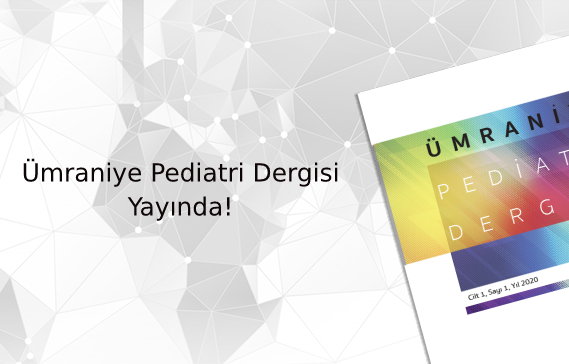2Afyonkarahisar Sağlık Bilimleri Üniversite Hastanesi, Çocuk Nöroloji Kliniği, Afyonkarahisar, Türkiye
Özet
Amaç: Katılma nöbetleri, çocukluk çağında sık görülen epileptik olmayan bir paroksismal bozukluktur. Bu çalışmanın amacı, katılma nöbetleri tanısı ile takip edilen hastaların klinik, laboratuvar ve tedavi yanıtlarını değerlendirmektir.
Gereç ve Yöntemler: Afyon Karahisar Sağlık Bilimleri Üniversite Hastanesi Çocuk Nöroloji Polikliniği’nde Aralık 2017-Ocak 2020 tarihleri arasında katılma nöbeti tanısı konulan 73 olgunun dosyaları geriye dönük olarak değerlendirildi. Tıbbi öykü, fizik muayene, tipi (solgun, siyanotik, karışık), derecesi (komplike, komplikasyonsuz), aile öyküsü, laboratuvar bulguları, elektrokardiyografi, ekokardiyografi ve elektroensefalografi bulguları kullanıldı.
Bulgular: Katılma nöbeti olgularının 41’i (%56) erkek, 32’si (%44) kadındı. Hastaların yaş ortalaması 21,7±14,5 (min-maks: 2-72) aydı. İki yaş altı 45 (%62) olgu tespit edildi. On bir (%15) olguda ailede katılma nöbeti öyküsü vardı. Yetmiş iki (%99) olguda fizik muayene normaldi. Olguların 65’i (%89) siyanotik, 5’i (%7) soluk tip ve 3’ü (%4) mikst tipteydi. Yirmi altı (%36) olguda komplike tip, 47 (%64) olguda komplike olmayan tip saptandı. Kırk iki (%58) olguda sadece demir eksikliği, 3 (%4) olguda B12 eksikliği ve 14 (%19) olguda demir eksikliği + B12 eksikliği tespit edildi. Katılma nöbeti olan olguların 56’sına (%75) demir, 14’üne (%19) demir+B±, 3’üne (%4) sadece B12 ve diğer tedavilerden fayda görmeyen 3 (%4) olguya pirasetam tedavisi verildi. Kırk iki demir eksikliği olgusunun 31’i (%73) demir tedavisine tam yanıt, 3’ü (%7) %50 veya daha fazla yanıt ve 2’si (%5) %50’den az yanıt verdi. Demir eksikliği veya B12 eksikliği olmayan 14 (%19) olguda demir tedavisine tam yanıt elde edildi. Demir+B12 tedavisi alan hastaların 12’sinde (%86) tam, 1’inde (%7) %50 ve üzeri, 1’inde (%7) %50’den az yanıt alındı. B12 veya pirasetam tedavisi verilen tüm hastalarda tam yanıt alındı.
Tartışma: Demir eksikliği olmamasına rağmen, katılma nöbetleri olan hastalarda demir tedavisinin fayda sağladığı bulundu. B12 eksikliği olan hastalarda B12 tedavisinin katılma nöbetlerini de azalttığı gözlemlendi. Bu bulgu literatür için yeni bir bilgi olmakla birlikte demir replasmanı yanında B12 replasmanı da tedavi seçenekleri arasında düşünülmelidir.
2Department of Pediatric Neurology, Afyonkarahisar Health Sciences University Hospital, Afyonkarahisar, Türkiye
Abstract
Objective: Breath holding spells (BHS) are common non-epileptic paroxysmal disorder in childhood. The aim of this study is to evaluate the clinical, laboratory, and treatment responses of patients followed up with BHS.
Material and Methods: The files of 73 cases diagnosed with BHS in the Paediatric Neurology Outpatient Clinic of Afyonkarahisar Health Sciences University Hospital between December 2017 and January 2020 were evaluated retrospectively. Medical history, physical examination (PE), spell type (pallid, cyanotic, and mixed), spell degree (complicated and uncomplicated), family history, laboratory findings, electrocardiography, echocardiography, and electroencephalography findings were used.
Results: Forty-one (56%) of the BHS cases were male and 32 (44%) were female. The mean age of the patients was 21.7±14.5 (min–max: 2–72) months. Forty-five cases (62%) under the age of 2 years were detected. There was a family history of BHS in 11 (15%) cases. PE was normal in 72 (99%) cases. Sixty-five (89%) of the cases were cyanotic, 5 (7%) were pallid type and 3 (4%) were mixed type. The complicated type was detected in 26 (36%) cases and the uncomplicated type in 47 (64%) cases. There were detected only iron deficiency (ID) in 42 (58%) cases, B12 deficiency in 3 cases (4%), ID+B12 deficiency in 14 cases (19%). Iron supplementation was given to 56 (75%) in cases, iron+B₁₂ treatment to 14 (19%) in cases, B₁₂ treatment to 3 (4%). The three cases who did not benefit with other treatments were given piracetam. There were 42 cases with ID. Thirty-one (73%) ID cases had a complete response to iron therapy, three ID cases (7%) had 50% or more response, and 2 cases (5%) had <50% response. Iron therapy had complete response in 14 (19%) cases without ID or B12 deficiency. Complete response was obtained in 12 (86%) cases, 50% or more were obtained in 1 (7%), and <50% were obtained in 1 (7%) of the patients who received iron+B₁₂ treatment. Complete response was obtained in all patients treated with B₁₂ or piracetam. In the cyanotic cases, complete response was obtained in 43 (66%), 50% and above in 4 (6%), and <50% in 2 (3%). Complete response was obtained in all pallid type cases. Of the mixed type cases, complete response was obtained in 2 cases (66%) and 50% and above response in 1 case (34%).
Conclusion: Patients with BHS was benefited from iron therapy, although there was no ID. In patients with B12 deficiency, B12 treatment had also been observed to reduce BHS. Although this finding is new information for the literature, B12 replacement treatment has also been observed to reduce BHS. This finding is new information for the literature. B12 replacement should be considered among the treatment options besides iron replacement.






 Aysel Burcu İbili1
Aysel Burcu İbili1 





